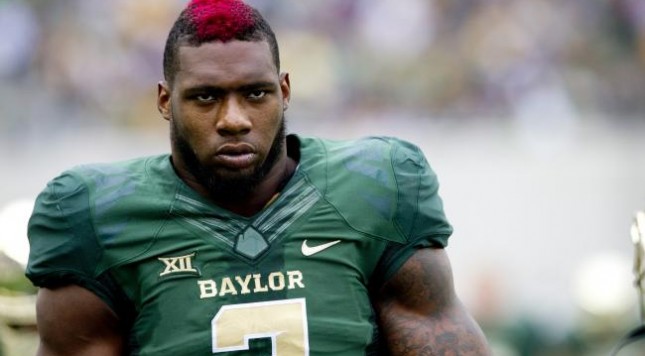The stories emerging about Baylor football are the latest in a series of reports.
That dry statement is intended to convey the following point: Stories might be released in the present moment, but the actual events they point to cover the past few years.
In other words, it’s not as though this most recent story is the latest alleged assault or the latest episode of potential negligence on the part of the Baylor athletic department and football coach Art Briles; it’s the latest revelation of what allegedly happened at an earlier point in time:
Shawn Oakman 2013 Incident Report Page 3 #BaylorScandal pic.twitter.com/Yrp4McNh1X
— Alex Dunlap (@AlexDunlapNFL) April 25, 2016
The story of Baylor football under Art Briles, if it turns out to be as bad as it might appear — we have to wait for more information to emerge — is not a story about the events of 2015 and 2016, at least not primarily.
The Oakman story above — like the Sam Ukwuachu case which burst into the national spotlight last August — is unsettling not for what it says about anyone involved in a 2015 or 2016 context. It’s unsettling because of what it might indicate about Baylor administrators and Briles in 2012 or 2013.
Cast to the side the fact that Baylor put out a Super Bowl Sunday statement on some of these matters, an evident attempt to minimize public scrutiny and pushback. That’s damage control well after the fact.
What’s more interesting, as the attempt to process this situation continues, is the mere idea that in 2012 and 2013, a football program might have been this negligent, this sloppy, this unresponsive to the presence of abusive behavior within its football program.
No, this wasn’t a case in which children were allegedly abused (and by a coach, not a player). Yet, should those obvious differences relative to Penn State make concerned citizens any less alarmed about what might have happened at Baylor? No, we don’t know if Art Briles knew about Shawn Oakman’s assault before putting him on a football field on Saturday afternoons, but the mere possibility that he might have is disturbing enough, don’t you think?
When one compiles the recent history of what’s happened in and around Waco over the past several years, it’s hard to arrive that the conclusion that Baylor and Briles have been fundamentally, professionally vigilant… and to be clear, that’s regardless of whether or not Briles knew about Oakman’s history before he allowed his defensive end to play:
Comprehensive timeline of the #BaylorScandal on @RedditCFB Seeing it all together is scary/sickening. Please share. https://t.co/d4gprHAbOM
— Alex Dunlap (@AlexDunlapNFL) April 26, 2016
When one considers the culture of Baylor, and when one then considers the simple fact that Oakman used to play at Penn State, but was responsibly kicked off the Nittany Lions by the school, it is as though the torch has been passed.
What Penn State once was, Baylor is now… but not just now: in 2012 and 2013, when the aftermath of the Penn State scandal was still fresh, breathed into one’s moral and ethical lungs every day.
In 2012, Joe Paterno died. In 2012, the Penn State-NCAA mess was just beginning. In 2012, the process of how to make institutions and athletic departments much more accountable to the public — especially in terms of preventing one coach (such as Joe Paterno) from wielding an inordinate amount of power or enabling a closed circle in the athletic department to protect the cash-cow football program — was not easy to ascertain.
Athletic directors and university presidents around the country spent 2012 discussing how to deal with these situations in the future… not merely as good public relations, but in terms of protecting the safety of vulnerable individuals and, more centrally, respecting those individuals as human persons.
Safety. Protection. Respect.
Accountability. Culture. Vigilance.
We’re nearly five years removed from the moment the Penn State story broke in November of 2011.
As each bit of evidence — each new report (most recently from Alex Dunlap) — emerges, it is increasingly more difficult to conclude that people in power at Baylor were paying any attention to better procedures and safeguards for vulnerable people in 2012 and on into 2013.
What has changed since Penn State?
How utterly ironic it is that a former Penn State player could wind up symbolizing Baylor’s failure to learn from what happened in Happy Valley.
It’s true that what’s happening at Baylor is not isolated. It’s helpful to recall that a big mess has unfolded at Tennessee, and moreover, that staged events such as this one point to the very same culture which seeks to protect the football program above all else:
In trying to help themselves on Tuesday, Tennessee coaches helped nobody: https://t.co/VbpjYAJatU pic.twitter.com/FKVpQdUzLl
— Matt Brown (@MattBrownCFB) February 24, 2016
The Penn State scandal — as awful and chilling as it was — had the potential to be a transformative moment within the culture of collegiate athletics. At Baylor and other places, it is hardly controversial to conclude that not even the smallest of transformations has occurred.
In the midst of sadness and anger and dismay — the natural (healthy) responses to a situation this disturbing — perhaps the cultural shift so many hoped for in November of 2011 can finally take root at more schools, and FBS football programs, across these United States.

